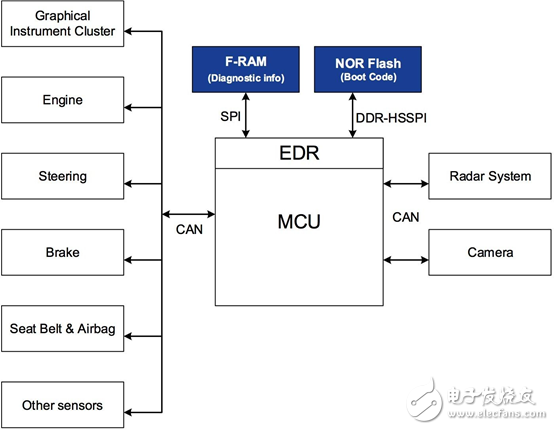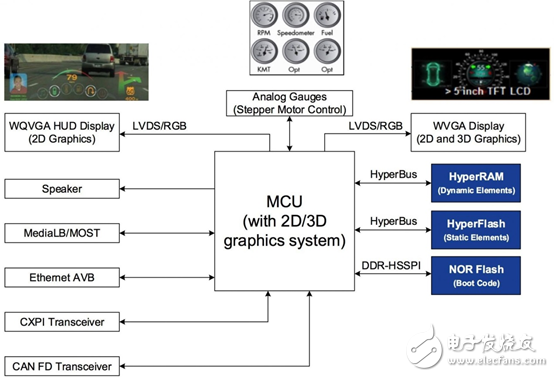The design of automotive systems is becoming more and more complex as new features such as advanced driver assistance, graphical instrumentation, body control and vehicle infotainment systems are constantly being added. To ensure reliable, secure operation, each subsystem requires the use of a specific non-volatile memory to store information during reset operations and power switching. Non-volatile memory is used to store important data such as executable code or constant data, calibration data, security features, and security-related information for future retrieval purposes.
These different types of non-volatile memories are currently on the market, such as NOR flash, NAND flash, EEPROM (erasable programmable read only memory), FRAM (ferroelectric memory), MRAM (magnetic RAM) and NVSRAM (non-volatile static memory), etc. Each type of memory has its own advantages and disadvantages under different performance indicators: memory density, read and write bandwidth, interface frequency, durability, data retention, current consumption in different power modes (boot, standby/sleep, hibernation), preparation Time, sensitivity to external electromagnetic interference, etc.
In order to understand the real need of the latest automotive systems for non-volatile memory, engineers need to consider real-life use cases:
?? After starting the car, is the driver willing to spend a few minutes waiting for the dashboard, odometer and fuel quantity graphics to display properly?
The driver adjusted the seat position, steering wheel position, temperature setting, and radio channel, but for some reason had to turn off the engine immediately. If the above subsystem fails to save the settings before the car is turned off, then the driver needs to come back again, isn't it very troublesome?
?? Although the car is equipped with an ADAS safety system, as a vehicle, accidents may still occur. Can you provide the insurance research team with the data you need, such as the status of different sensors a few seconds before the accident?
For example, in the case of an ADAS system, it is important to collect and store real-time data from a specific sensor to a non-volatile memory. Similarly for automotive entertainment systems, it is also important to be able to store system setup information while the system is powered down. Both GIS and infotainment systems have HD graphics that not only need to store and read boot programs but also need to store and read very large configurations from external non-volatile memory.
In addition to meeting the needs of the application, non-volatile memory also needs to ensure sufficient read and write times to record at least 20 years of data. In addition, in order to achieve automotive-level certification and qualification, all subsystems should use AEC-Q100 compliant memory components. At the same time, the functional safety performance in accordance with the ISO26262 standard is another system that requires such high security requirements.
ADAS memory requirementsThe ADAS system is designed to automate/automatically adjust/enhance the automotive system for a safer and more comfortable driving experience. The safety function is mainly used to avoid accidents by alerting the driver to potential problems, or by implementing protective measures and taking over the control of the car to avoid collisions. Adaptive features include automatic lighting, adaptive cruise control, automatic braking, combined GPS/traffic warnings, connection to a smartphone, alerting the driver to other vehicles or dangerous conditions, keeping the driver in the right lane, and displaying the driver's Blind spot.

Figure 1. Block diagram of the ADAS system
Figure 1 shows a simplified block diagram of how the ADAS system utilizes FRAM and NOR flash. External NOR flash is typically used to store boot code. However, various sensors in the ADAS system periodically send data to the MCU via a CAN (Controller Area Network) interface. The MCU runs an adaptive algorithm to check for possible collisions or collisions. The runtime variables of the processing algorithm and the current state of the sensor are stored in the memory of the MCU.
When the algorithm detects an accident, the airbag control module immediately activates the backup power supply and turns on the airbag to ensure that the power can be deployed during the accident. The sensor status at the time of the accident should also be immediately stored in non-volatile memory for data logging. These data can effectively help understand the cause of the accident, prompt the car manufacturer to produce a more advanced safety system, and assist the insurance company to determine whether the claim is valid.
The Driving Recorder (EDR) is a system for recording data on important subsystems prior to an accident. It can be installed in the ADAS main control unit or in another MCU that receives important sensor data and communicates with the ADASMCU. Today, engineers can use a multi-core device to provide a dedicated, complete CPU core for EDR functions, such as Cypress's TraveoTM automotive microcontrollers.
EDR judges the collision by measuring the impact force, vehicle speed, engine speed, steering input, throttle position, braking status, seat belt status (detecting passengers), tire pressure, warning signal and airbag opening status of the front pressure sensor of the car. degree. And the above data is recorded before and during the collision of the car. Obviously, the microcontroller can't wait until an accident occurs to start recording data. Therefore, the microcontroller needs to store data continuously. Therefore, EDR requires a non-volatile memory with almost unlimited write times.
FRAM memory has more advantages than ADAS's traditional EEPROM. It is important for ADAS to store important data (actually 10us storage time) in real time without writing waits. EEPROMs typically require write latency of more than 10 milliseconds and are therefore not suitable for high security applications. FRAM has both write-free latency and high-speed clock speed, making it ideal for applications that need to write large amounts of data quickly. When using SPI, the designer is free to determine the number of bytes written to FRAM. When one or two bytes are written to a random location of the FRAM, the write cycle is approximately 1 microsecond. In contrast to EEPROM or flash memory, a 5-10 millisecond write cycle is required.
Unlike EEPROM or flash, FRAM does not require a page buffer. After receiving the 8th bit of each byte, the FRAM writes each data byte immediately. This means that when the system memory density grows, engineers don't have to worry about page buffer size changes.
In terms of write endurance, FRAM can support 10 billion write operations, far exceeding 1 million EEPROMs and 100,000 flash memories. Therefore, FRAM can be used as a tracking data logger that can continuously write data. In addition, FRAM write and read power consumption is very low (for example, 300 microamps at 1Mhz), so it is very suitable for ADAS that requires low-power backup power or data to be written by capacitor when an accident occurs. The FRAM has a much lower standby current (typically 100 microamps) compared to other non-volatile memories.
Car dashboard requirements for memoryThe dashboard system displays important information such as speed, speed, fuel level and engine temperature on a graphical display in digital form, or in an analog form controlled by a stepper motor. In addition, the dashboard system can also display battery warnings, temperature warnings, low oil pressure warnings, brake warnings, seat belt status indicators, low tire pressure signs, door lock signs, headlight signs, shift indications, handbrake status indications, and In- and outside temperature, odometer readings, etc.
The latest dashboard system also includes a head-up display (HUD). A head-up display is an optical system that projects driving information onto the windshield of a car. With a head-up display, the driver can easily view important driving information while keeping his eyes on the traffic ahead. This reduces the potential risk of leaving the road and gives the driver extra time to identify and react to risk factors. Head-up displays display speed, navigation, and other important warning symbols.

Figure 2. Dashboard system block diagram
Figure 2 shows a simplified block diagram of the dashboard installed around HyperRAM and HyperFlash (connected to the HyperBus interface) and NOR flash (connected to the DDR-HSSPI interface). The instrument panel MCU can connect to other subsystems through different communication protocols such as CAN-FD, CXPI (Clock Extended Peripheral Interface), Ethernet AVB, MediaLB (Media Local Bus)/MOST (Media Oriented System Transmission) to collect information and Displayed on the dashboard.
Once the dashboard system is started, the security engine immediately verifies the authenticity of the firmware. Subsequently, the XiP is executed from the NOR flash memory through the HyperBus interface from the external HyperFlash or through the DDR-switched DDR-HSSPI interface, and the MCU software starts execution. The XiP function allows the MCU to execute code directly from external memory without having to copy the external flash code to internal RAM first, which improves response speed. The NOR Flash/HyperFlash memory configures the initial address location of the program code and starts in read mode after a specified clock delay. Therefore, once the MCU is started, it can directly acquire the code that needs to be executed without delaying the time by providing the address and reading the command.
Static elements can be obtained from external HyperFlash and displayed as the base layer of the dashboard LCD. Automotive MCUs, such as the Cypress TraveoTM series, provide additional feature support to instantly decompress static HMI elements without first passing through RAM. Dynamic content such as dashboard needle information has a faster update rate and can be retrieved from external HyperRAM.
Memory requirements for HVAC and infotainment systemsThe HVAC (Heating, Ventilation and Air Conditioning) system is responsible for controlling the temperature and air flow inside the vehicle. The infotainment system can run a variety of applications similar to smartphones and provide a user interface to change HVAC system configuration, music system settings, enter destinations in navigation applications, adjust seat/steer wheel position/height, and adjust interior lighting, etc. . Some of the latest cars have also added fingerprint readers to verify driver identity. This allows HVAC and infotainment systems to quickly adjust in-vehicle settings based on driver preferences.

Figure 3. Block diagram of HVAC and infotainment systems
Figure 3 shows a simplified block diagram of HVAC and infotainment systems, all connected to the main MCU. Three additional subsystems are compared to the dashboard system:
?? Touch screen controller for detecting finger touch on the display
?? Heating / air conditioning, control the temperature inside the car
?? Connect the subsystem to achieve multiple connections in the car (Bluetooth, GPS, WiFi, GSM, FM tuner, etc.)
Automotive Wire
Made is Jiangsu, China, we produce a wide range of automotive wires with the applications of LED, instrument, ignition system, ESP & ABS, seat heating and window control that meet UL, VDE, JASO standard, also OEM specifications. Our PVC insulation is tough enough to resist grease, oil, and acid according to ISO6722, and has a temperature rating of 176°F (80°C). If you need a higher temperature and performance wire, use cross-linked wire instead. Each bare copper wire core is composed of pure copper with high conductivity, flexibility, and durability. Packing is available in small bundles, and larger spools.
Automotive Wire,Vehicle Wiring,Car Electrical Wiring,Bus Wire
Feyvan Electronics Technology Co., Ltd. , https://www.fv-cable-assembly.com